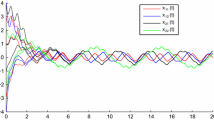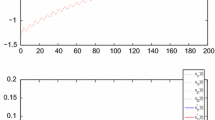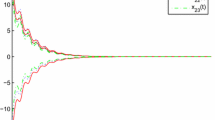Abstract
The dynamics of retarded shunting inhibitory cellular neural networks (SICNNs) with rectangular input currents is investigated from the asymptotic point of view. It is rigorously proved that such networks possess homoclinic and heteroclinic outputs under certain conditions. Illustrative examples that support the theoretical results are provided. Moreover, the extension of the homoclinical structure is numerically demonstrated for unidirectionally coupled retarded SICNNs.




Similar content being viewed by others
References
Poincaré H (1899) Les Methodes Nouvelles de la Mecanique Celeste. Gauthier-Villars et fils, Paris
Gonchenko SV, Shil’nikov LP, Turaev DV (1996) Dynamical phenomena in systems with structurally unstable Poincaré homoclinic orbits. Chaos 6:15–31
Shil’nikov LP (1967) On a Poincaré-Birkhoff problem. Math USSR-Sbornik 3:353–371
Smale S (1965) Diffeomorphisms with many periodic points. In: Cairns SS (ed) Differential and combinatorial topology: a symposium in honor of marston morse. Princeton University Press, Princeton, pp 63–70
Bertozzi AL (1988) Heteroclinic orbits and chaotic dynamics in planar fluid flows. Siam J Math Anal 19:1271–1294
Chacón R, Bejarano JD (1995) Homoclinic and heteroclinic chaos in a triple-well oscillator. J Sound Vib 186:269–278
Rabinovich M, Volkovskii A, Lecanda P, Huerta R, Abarbanel HDI, Laurent G (2001) Dynamical encoding by networks of competing neuron groups: winnerless competition. Phys Rev Lett 87:068102
Coullet P, Riera C, Tresser C (2004) A new approach to data storage using localized structures. Chaos 14:193–198
Bouzerdoum A, Pinter RB (1993) Shunting inhibitory cellular neural networks: derivation and stability analysis. IEEE Trans Circuits Syst I Fundam Theory Appl 40:215–221
Bouzerdoum A, Pinter RB (1990) A shunting inhibitory motion detector that can account for the functional characteristics of fly motion-sensitive interneurons. In: Proceedings of IJCNN international joint conference on neural networks, San Diego, CA, USA, pp 149–153
Carpenter GA, Grossberg S (1988) The ART of adaptive pattern recognition by a self-organizing neural network. Computer 21:77–88
Fukushima K (1989) Analysis of the process of visual pattern recognition by the neocognitron. Neural Netw 2:413–420
Jernigan ME, McLean GF (1992) Lateral inhibition and image processing. In: Nabet B, Printer RB (eds) Nonlinear vision. CRC Press, Boca Raton, pp 451–462
Pinter RB, Olberg RM, Warrant E (1989) Luminance adaptation of preferred object size in identified dragonfly movement detectors. In: Proceedings of IEEE international conference on systems, man and cybernetics, pp 682–686
Yao L (2017) Global exponential convergence of neutral type shunting inhibitory cellular neural networks with D operator. Neural Process Lett 45:401–409
Peng G, Huang L (2009) Anti-periodic solutions for shunting inhibitory cellular neural networks with continuously distributed delays. Nonlinear Anal Real World Appl 10:2434–2440
Wang P, Li B, Li Y (2015) Square-mean almost periodic solutions for impulsive stochastic shunting inhibitory cellular neural networks with delays. Neurocomputing 167:76–82
Huang X, Cao J (2003) Almost periodic solution of shunting inhibitory cellular neural networks with time-varying delay. Phys Lett A 314:222–231
Zhang A (2017) Pseudo almost periodic solutions for SICNNs with oscillating leakage coefficients and complex deviating arguments. Neural Process Lett 45:183–196
Zhang A (2017) Pseudo almost periodic solutions for neutral type SICNNs with D operator. J Exp Theor Artif Intell 29:795–807
Zhang A (2017) Almost periodic solutions for SICNNs with neutral type proportional delays and D operators. Neural Process Lett. https://doi.org/10.1007/s11063-017-9631-5
Zhou Q, Shao J (2016) Weighted pseudo-anti-periodic SICNNs with mixed delays. Neural Comput Appl. https://doi.org/10.1007/s00521-016-2582-3
Shao J (2008) Anti-periodic solutions for shunting inhibitory cellular neural networks with time-varying delays. Phys Lett A 372:5011–5016
Liu X (2015) Exponential convergence of SICNNs with delay sand oscillating coefficients in leakage terms. Neurocomputing 168:500–504
Chen Z (2013) A shunting inhibitory cellular neural network with leakage delays and continuously distributed delays of neutral type. Neural Comput Appl 23:2429–2434
Akhmet M, Fen MO, Kirane M (2016) Almost periodic solutions of retarded SICNNs with functional response on piecewise constant argument. Neural Comput Appl 27:2483–2495
Zhao C, Wang Z (2015) Exponential convergence of a SICNN with leakage delays and continuously distributed delays of neutral type. Neural Process Lett 41:239–247
Ou C (2009) Almost periodic solutions for shunting inhibitory cellular neural networks. Nonlinear Anal Real World Appl 10:2652–2658
Peng L, Wang W (2013) Anti-periodic solutions for shunting inhibitory cellular neural networks with time-varying delays in leakage terms. Neurocomputing 111:27–33
Gui Z, Ge W (2006) Periodic solution and chaotic strange attractor for shunting inhibitory cellular neural networks with impulses. Chaos 16:033116
Akhmet MU, Fen MO (2013) Shunting inhibitory cellular neural networks with chaotic external inputs. Chaos 23:023112
Akhmet MU, Fen MO (2015) Attraction of Li-Yorke chaos by retarded SICNNs. Neurocomputing 147:330–342
Akhmet M, Fen MO, Kıvılcım A (2016) Li-Yorke chaos generation by SICNNs with chaotic/almost periodic postsynaptic currents. Neurocomputing 173:580–594
Fen MO, Akhmet M (2016) Impulsive SICNNs with chaotic postsynaptic currents. Discret Contin Dyn Syst Ser B 21:1119–1148
Fen MO, Tokmak Fen F (2017) SICNNs with Li-Yorke chaotic outputs on a time scale. Neurocomputing 237:158–165
Marcus CM, Westervelt RM (1989) Stability of analog neural networks with delay. Phys Rev A 39:347–359
Cao J (2000) Global asymptotic stability of neural networks with transmission delays. Int J Syst Sci 31:1313–1316
Roska T, Chua LO (1992) Cellular neural networks with non-linear and delay-type template elements and non-uniform grids. Int J Circuit Theory Appl 20:469–481
Akhmet MU (2008) Hyperbolic sets of impact systems. Dyn Contin Discrete Impuls Syst Ser A Math. Anal. 15 (Suppl. S1):1-2. In: Proceedings of the \(5\)th international conference on impulsive and hybrid dynamical systems and applications, Beijing, Watan Press
Akhmet MU (2010) Homoclinical structure of the chaotic attractor. Commun Nonlinear Sci Numer Simul 15:819–822
Akhmet MU (2009) Devaney’s chaos of a relay system. Commun Nonlinear Sci Numer Simul 14:1486–1493
Fen MO, Tokmak Fen F (2017) Homoclinic and heteroclinic motions in hybrid systems with impacts. Math Slovaca 67:1179–1188
Chen SS (2009) Delayed transiently chaotic neural networks and their application. Chaos 19:033125
Li Q, Tang S, Zeng H, Zhou T (2014) On hyperchaos in a small memristive neural network. Nonlinear Dyn 78:1087–1099
Zou F, Katérle A, Nossek JA (1993) Homoclinic and heteroclinic orbits of the three-cell cellular neural networks. IEEE Trans Circuits Syst I Fundam Theory Appl 40:843–848
Shil’nikov LP (1969) On a new type of bifurcation of multidimensional dynamical systems. Sov Math Dokl 10:1368–1371
Wang T, He X, Huang T (2016) Complex dynamical behavior of neural networks in circuit implementation. Neurocomputing 190:95–106
Izhikevich EM (1999) Weakly connected quasi-periodic oscillators, FM interactions, and multiplexing in the brain. SIAM J Appl Math 59:2193–2223
Hoppensteadt FC, Izhikevich EM (1997) Weakly connected neural networks. Springer, New York
Pasemann F, Hild M, Zahedi K (2003) SO(2)-Networks as neural oscillators. In: Mira J, Álvarez JR (eds) Computational methods in neural modeling. IWANN 2003. Lecture notes in computer science, vol 2686. Springer, Berlin, Heidelberg
Tyagi BK, Mehotra RK (1976) Special type of emitter-coupled rectangular pulse generator. In: IEE-IERE Proceedings, India, pp 223–227
Ping W, Jiali B, Hong W, Huiping W (2003) Multi-pulse generator for electroporation. In: Proceedings of the 25th annual international conference of the IEEE EMBS, Cancun, Mexico, September 17-21, pp 2970–2973
Driver RD (1977) Ordinary and delay differential equations. Springer, New York
Filippov AF (1988) Differential equations with discontinuous righthand sides: control systems. Springer, Berlin
Akhmet M (2011) Nonlinear hybrid continuous/discrete-time models. Atlantis Press, Paris
Zhang Z, Quan Z (2015) Global exponential stability via inequality technique for inertial BAM neural networks with time delays. Neurocomputing 151:1316–1326
Hale J, Koçak H (1991) Dynamics and Bifurcations. Springer, New York
Avrutin V, Schenke B, Gardini L (2015) Calculation of homoclinic and heteroclinic orbits in 1D maps. Commun Nonlinear Sci Numer Simul 22:1201–1214
Acknowledgements
The authors wish to express their sincere gratitude to the referees for the helpful criticism and valuable suggestions, which helped to improve the paper significantly.
Author information
Authors and Affiliations
Corresponding author
Additional information
Publisher's Note
Springer Nature remains neutral with regard to jurisdictional claims in published maps and institutional affiliations.
Appendix
Appendix
The proof of Lemma 2.1 is as follows.
Proof of Lemma 2.1
Let us denote by \(\mathcal {B}_0\) the set of continuous and uniformly bounded functions \(v(t)=\left\{ v_{ij}(t)\right\} \), \(i=1,2,\ldots ,m\), \(j=1,2,,\ldots ,n\), which are defined on \({\mathbb {R}}\), such that \(\left\| v\right\| _{\infty } \le K_0\), where \(\left\| v\right\| _{\infty }= \sup _{t\in {\mathbb {R}}}\left\| v(t)\right\| \).
We fix a solution \(\zeta =\left\{ \zeta _k\right\} _{k\in {\mathbb {Z}}}\) of the map (2.2) and define an operator \(\Phi \) on the set \(\mathcal {B}_0\) by
where \(\Phi v(t)=\left\{ \left( \Phi v(t)\right) _{ij}\right\} \).
If \(v(t) \in \mathcal {B}_0\), then
The last inequality yields
Therefore, we have \(\Phi (\mathcal {B}_0)\subseteq \mathcal {B}_0\).
On the other hand, if v(t) and \(\overline{v}(t)\) belong to \(\mathcal {B}_0\), then one can confirm that
Hence, the inequality \(\left\| \Phi v - \Phi \overline{v}\right\| _{\infty } \le (M_f + K_0 L_f) \delta \left\| v-\overline{v}\right\| _{\infty }\) is valid, and accordingly the operator \(\Phi \) is a contraction since \((M_f + K_0 L_f)\delta <1\).
Consequently, for each orbit \(\zeta =\left\{ \zeta _k\right\} _{k\in {\mathbb {Z}}}\) of (2.2), SICNN (2.1) possesses a unique bounded solution \(\phi _{\zeta }(t) = \left\{ \phi _{\zeta }^{ij}(t)\right\} \) such that \(\sup _{t\in {\mathbb {R}}} \left\| \phi _{\zeta }(t)\right\| \le K_0.\)\(\square \)
Rights and permissions
About this article
Cite this article
Fen, M.O., Tokmak Fen, F. Homoclinical Structure of Retarded SICNNs with Rectangular Input Currents. Neural Process Lett 49, 521–538 (2019). https://doi.org/10.1007/s11063-018-9832-6
Published:
Issue Date:
DOI: https://doi.org/10.1007/s11063-018-9832-6




